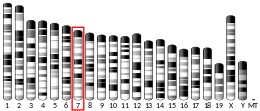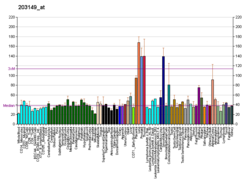폴리오바이러스수용체관련2
Poliovirus receptor-related 2폴리오바이러스 수용체 관련 2(PVRL2)는 사람 혈장막 당단백질이다.[5]
기능.
이 유전자는 Ig-like C2-type 도메인과 Ig-like V-type 도메인으로 단일 패스형 I막 당단백질을 코드한다.이 단백질은 아데렌 접합부의 혈장막 성분 중 하나이다.그것은 또한 단순 헤르페스 바이러스 및 가성포진 바이러스의 특정 돌연변이 변종의 진입로 역할을 하며, 이러한 바이러스의 세포간 확산에 관여한다.이 유전자의 변화는 다발성 경화증의 심각도의 차이와 관련이 있다.다른 Isoform을 인코딩하는 대체 전사 스플라이스 변형이 [5]특징지어졌습니다.
「 」를 참조해 주세요.
레퍼런스
- ^ a b c GRCh38: 앙상블 릴리즈 89: ENSG00000130202 - 앙상블, 2017년 5월
- ^ a b c GRCm38: 앙상블 릴리즈 89: ENSMUSG000062300 - 앙상블, 2017년 5월
- ^ "Human PubMed Reference:". National Center for Biotechnology Information, U.S. National Library of Medicine.
- ^ "Mouse PubMed Reference:". National Center for Biotechnology Information, U.S. National Library of Medicine.
- ^ a b "Entrez Gene: PVRL2 poliovirus receptor-related 2 (herpesvirus entry mediator B)".
추가 정보
- Eberlé F, Dubreuil P, Mattei MG, et al. (1995). "The human PRR2 gene, related to the human poliovirus receptor gene (PVR), is the true homolog of the murine MPH gene". Gene. 159 (2): 267–72. doi:10.1016/0378-1119(95)00180-E. PMID 7622062.
- Warner MS, Geraghty RJ, Martinez WM, et al. (1998). "A cell surface protein with herpesvirus entry activity (HveB) confers susceptibility to infection by mutants of herpes simplex virus type 1, herpes simplex virus type 2, and pseudorabies virus". Virology. 246 (1): 179–89. doi:10.1006/viro.1998.9218. PMID 9657005.
- Freistadt MS, Eberle KE (1998). "Physical association between CD155 and CD44 in human monocytes". Mol. Immunol. 34 (18): 1247–57. doi:10.1016/S0161-5890(98)00003-0. PMID 9683266.
- Lopez M, Aoubala M, Jordier F, et al. (1999). "The human poliovirus receptor related 2 protein is a new hematopoietic/endothelial homophilic adhesion molecule". Blood. 92 (12): 4602–11. doi:10.1182/blood.V92.12.4602. PMID 9845526.
- Shukla D, Rowe CL, Dong Y, et al. (1999). "The Murine Homolog (Mph) of Human Herpesvirus Entry Protein B (HveB) Mediates Entry of Pseudorabies Virus but Not Herpes Simplex Virus Types 1 and 2". J. Virol. 73 (5): 4493–7. doi:10.1128/JVI.73.5.4493-4497.1999. PMC 104343. PMID 10196354.
- Takahashi K, Nakanishi H, Miyahara M, et al. (1999). "Nectin/PRR: An Immunoglobulin-like Cell Adhesion Molecule Recruited to Cadherin-based Adherens Junctions through Interaction with Afadin, a PDZ Domain–containing Protein". J. Cell Biol. 145 (3): 539–49. doi:10.1083/jcb.145.3.539. PMC 2185068. PMID 10225955.
- Freitas EM, Zhang WJ, Lalonde JP, et al. (1999). "Sequencing of 42kb of the APO E-C2 gene cluster reveals a new gene: PEREC1". DNA Seq. 9 (2): 89–100. doi:10.3109/10425179809086433. PMID 10520737.
- Lopez M, Cocchi F, Menotti L, et al. (2000). "Nectin2α (PRR2α or HveB) and Nectin2δ Are Low-Efficiency Mediators for Entry of Herpes Simplex Virus Mutants Carrying the Leu25Pro Substitution in Glycoprotein D". J. Virol. 74 (3): 1267–74. doi:10.1128/JVI.74.3.1267-1274.2000. PMC 111461. PMID 10627537.
- Cocchi F, Menotti L, Dubreuil P, et al. (2000). "Cell-to-Cell Spread of Wild-Type Herpes Simplex Virus Type 1, but Not of Syncytial Strains, Is Mediated by the Immunoglobulin-Like Receptors That Mediate Virion Entry, Nectin1 (PRR1/HveC/HIgR) and Nectin2 (PRR2/HveB)". J. Virol. 74 (8): 3909–17. doi:10.1128/JVI.74.8.3909-3917.2000. PMC 111902. PMID 10729168.
- Bouchard MJ, Dong Y, McDermott BM, et al. (2000). "Defects in Nuclear and Cytoskeletal Morphology and Mitochondrial Localization in Spermatozoa of Mice Lacking Nectin-2, a Component of Cell-Cell Adherens Junctions". Mol. Cell. Biol. 20 (8): 2865–73. doi:10.1128/MCB.20.8.2865-2873.2000. PMC 85510. PMID 10733589.
- Martinez WM, Spear PG (2001). "Structural Features of Nectin-2 (HveB) Required for Herpes Simplex Virus Entry". J. Virol. 75 (22): 11185–95. doi:10.1128/JVI.75.22.11185-11195.2001. PMC 114698. PMID 11602758.
- Freitas EM, Phan TC, Herbison CE, et al. (2002). "The poliovirus receptor related 2 (PRR2) and apolipoprotein E genes and coronary heart disease". Journal of Cardiovascular Risk. 9 (1): 59–65. doi:10.1097/00043798-200202000-00009. PMID 11984219.
- Fabre S, Reymond N, Cocchi F, et al. (2002). "Prominent role of the Ig-like V domain in trans-interactions of nectins. Nectin3 and nectin 4 bind to the predicted C-C'-C"-D beta-strands of the nectin1 V domain". J. Biol. Chem. 277 (30): 27006–13. doi:10.1074/jbc.M203228200. PMID 12011057.
- Struyf F, Martinez WM, Spear PG (2002). "Mutations in the N-Terminal Domains of Nectin-1 and Nectin-2 Reveal Differences in Requirements for Entry of Various Alphaherpesviruses and for Nectin-Nectin Interactions". J. Virol. 76 (24): 12940–50. doi:10.1128/JVI.76.24.12940-12950.2002. PMC 136698. PMID 12438620.
- Strausberg RL, Feingold EA, Grouse LH, et al. (2003). "Generation and initial analysis of more than 15,000 full-length human and mouse cDNA sequences". Proc. Natl. Acad. Sci. U.S.A. 99 (26): 16899–903. Bibcode:2002PNAS...9916899M. doi:10.1073/pnas.242603899. PMC 139241. PMID 12477932.
- Bottino C, Castriconi R, Pende D, et al. (2003). "Identification of PVR (CD155) and Nectin-2 (CD112) as Cell Surface Ligands for the Human DNAM-1 (CD226) Activating Molecule". J. Exp. Med. 198 (4): 557–67. doi:10.1084/jem.20030788. PMC 2194180. PMID 12913096.
- Zago A, Spear PG (2003). "Differences in the N Termini of Herpes Simplex Virus Type 1 and 2 gDs That Influence Functional Interactions with the Human Entry Receptor Nectin-2 and an Entry Receptor Expressed in Chinese Hamster Ovary Cells". J. Virol. 77 (17): 9695–9. doi:10.1128/JVI.77.17.9695-9699.2003. PMC 187405. PMID 12915581.
- Tahara-Hanaoka S, Shibuya K, Onoda Y, et al. (2005). "Functional characterization of DNAM-1 (CD226) interaction with its ligands PVR (CD155) and nectin-2 (PRR-2/CD112)". Int. Immunol. 16 (4): 533–8. doi:10.1093/intimm/dxh059. PMID 15039383.
- Brandenberger R, Wei H, Zhang S, et al. (2005). "Transcriptome characterization elucidates signaling networks that control human ES cell growth and differentiation". Nat. Biotechnol. 22 (6): 707–16. doi:10.1038/nbt971. PMID 15146197. S2CID 27764390.
- Rosche B, Cepok S, Stei S, et al. (2004). "The role of the polio virus receptor and the herpesvirus entry mediator B genes for the development of MS". J. Neuroimmunol. 156 (1–2): 171–7. doi:10.1016/j.jneuroim.2004.07.001. PMID 15465608. S2CID 39448365.





